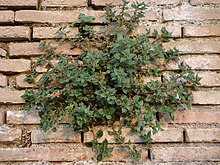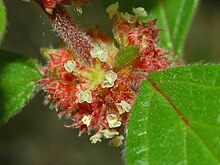Spread out glass herb
| Spread out glass herb | ||||||||||||
|---|---|---|---|---|---|---|---|---|---|---|---|---|
|
Spreading glass herb ( Parietaria judaica ) |
||||||||||||
| Systematics | ||||||||||||
|
||||||||||||
| Scientific name | ||||||||||||
| Parietaria judaica | ||||||||||||
| L. |
The spreading glass herb ( Parietaria judaica ), also called wall glass herb , is a species of the nettle family (Urticaceae).
description
Vegetative characteristics
The spreading glass herb grows as a perennial, herbaceous plant and reaches heights of 10 to 80 centimeters. The hairy to bald stem is erect or prostrate and can become lignified at the base. The leaves are divided into a petiole and a leaf blade. The 0.3 to 2 centimeter long petiole is hairy. The pressed down, hairy to bald leaf blade is 1 to 9 centimeters long and 0.5 to 4.5 centimeters wide, lanceolate-ovate to ovoid-elliptical with a narrowed, wedge-shaped or broadly rounded, rarely almost heart-shaped base and a pointed blade tip.
Generative characteristics
Few to many flowers are grouped together in compact, zymous inflorescences that are individually located in the leaf axils . The initially 1.5 to 3 millimeters long, lanceolate-egg-shaped to elliptical, blunt bracts are somewhat fused at the base and enlarge until the fruit is ripe. The mostly hermaphroditic, greenish flowers are 2 to 3.5 millimeters in diameter. The sepals are about 3 mm long and curved inward.
The stalked, shiny dark brown nuts are egg-shaped with a length of 1 to 1.5 millimeters and a width of 0.6 to 0.9 millimeters. They have a pointed upper end with no or a tiny spike tip.
Heyday
The spreading glass herb blooms in Central Europe from June to October. In the Mediterranean and areas with a comparable climate, most plants bloom from March to June, but in principle the plants are able to bloom all year round.
Chromosome number
The spreading glass herb has the chromosome number 2n = 26.
Distribution and location
The natural range of the spreading glass herb includes southern and western Europe, North Africa including the Atlantic islands as well as front and central Asia eastwards to Kashmir and Nepal. Reports from western China and Tibet are not confirmed by the Flora of China . Occurrences in the Azores are certainly based on introduction, possibly also those in the Canary Islands . The spreading glass herb was introduced into North America, Peru, Argentina, Uruguay and Chile, Australia and New Zealand.
In Germany, the main deposits are in the Rhine Valley and its tributaries. Occurrences further east, like those in Austria and the Czech Republic, are mostly newer introductions of a temporary nature. In Switzerland, the spreading glass herb occurs more frequently on the southern side of the Alps in Ticino and on Lake Geneva , as well as in South Tyrol .
The spreading glass herb occurs in shady, damp seeped, but south-exposed, nitrogen-influenced humus crevices, in Central Europe typically in wall crevices and at wall bases. It is a character species of the Parietarietum judaicae and supraregional of the order Parietarietalia judaicae.
ecology
The species is spread by ants .
Taxonomy
The first release of Parietaria judaica was made in 1756 by Carl Linnaeus in Flora Palestine 32. synonyms for Parietaria judaica L. are Parietaria diffusa Mert. ex WDJKoch , Parietaria jaxartica Pavlov , Parietaria officinalis subsp. judaica (L.) Bég. Moench , Parietaria ramiflora .
swell
- David E. Boufford: Urticaceae. In: Flora of North America Editorial Committee (Ed.): Flora of North America North of Mexico . Volume 3: Magnoliophyta: Magnoliidae and Hamamelidae . Oxford University Press, New York / Oxford a. a. 1997, ISBN 0-19-511246-6 , pp. 407 (English, online ).
- Abdul Ghafoor: Flora of Pakistan 137: Urticaceae . Department of Botany, University of Karachi, Karachi 1981, p. 11 ( online ).
Individual evidence
- ↑ Rolf Wisskirchen, Henning Haeupler: Standard list of fern and flowering plants in Germany. With chromosome atlas . Ed .: Federal Agency for Nature Conservation (= The fern and flowering plants of Germany . Volume 1 ). Eugen Ulmer, Stuttgart (Hohenheim) 1998, ISBN 3-8001-3360-1 , p. 352 .
- ↑ a b c d e David E. Boufford: Urticaceae. In: Flora of North America Editorial Committee (Ed.): Flora of North America North of Mexico . Volume 3: Magnoliophyta: Magnoliidae and Hamamelidae . Oxford University Press, New York / Oxford a. a. 1997, ISBN 0-19-511246-6 , pp. 407 (English, online ).
- ↑ a b c Abdul Ghafoor: Flora of Pakistan 137: Urticaceae . Department of Botany, University of Karachi, Karachi 1981, p. 11 ( online ).
- ↑ B. Quinger: Urticaceae. In: Oskar Sebald, Siegmund Seybold, Georg Philippi (eds.): The fern and flowering plants of Baden-Württemberg . tape 2 : Special part (Spermatophyta, subclass Dilleniidae): Hypericaceae to Primulaceae . Eugen Ulmer, Stuttgart (Hohenheim) 1990, ISBN 3-8001-3312-1 , pp. 65-66 .
- ↑ a b Annette Carlström: Parietaria. In: Arne Strid, Kit Tan (ed.): Flora Hellenica. Volume One (Gymnospermae to Caryophyllaceae) . Koeltz Scientific Books, Königstein 1997, ISBN 3-87429-391-2 , p. 59 .
- ^ Sandro Pignatti (ed.): Flora d'Italia . Vol. 1. Edagricole, Bologna 2003, ISBN 88-506-2449-2 , pp. 127–128 (third unaltered reprint of the 1st edition from 1982).
- ^ A b John Robert Press, Krishna Kumar Shrestha, David Andrew Sutton: Annotated checklist of the flowering plants of Nepal. Natural History Museum, London 2000, ISBN 0-565-09154-9 , updated version online.
- ↑ Chen Jiarui, Ib Friis, C. Melanie Wilmot-Dear: Parietaria. In: Wu Zhengyi, Peter H. Raven, Deyuan Hong (Eds.): Flora of China . Volume 5: Ulmaceae through Basellaceae . Science Press / Missouri Botanical Garden Press, Beijing / St. Louis 2003, ISBN 1-930723-27-X , pp. 189 (English, online - PDF file ).
- ↑ Pertti Uotila: Urticaceae, Parietaria judaica . In: Euro + Med Plantbase - the information resource for Euro-Mediterranean plant diversity. Berlin 2011.
- ↑ a b Parietaria judaica at Tropicos.org. Missouri Botanical Garden, St. Louis, accessed June 8, 2012.
- ↑ Flora del Conosur.
- ^ CJ Webb, WR Sykes, PJ Garnock-Jones: Flora of New Zealand. Volume IV: Naturalized Pteridophytes, Gymnosperms, Dicotyledons. 1988, ISBN 0-477-02529-3 , online .
- ^ Pacific Island Ecosystems at Risk (PIER): Parietaria judaica , accessed September 15, 2012.
- ↑ a b c Gerhard Wagenitz (Ed.): Illustrated flora of Central Europe. Pteridophyta, Spermatophyta . Founded by Gustav Hegi. 3rd, revised and expanded edition. Volume III. Part 1: Angiospermae: Dicotyledones 1 (Juglandaceae - Polygonaceae) . Paul Parey, Berlin / Hamburg 1981, ISBN 3-489-59020-1 , p. 306–307, 474–475 (reprint of the 2nd edition from 1957/1958 with addendum).
- ↑ a b c Erich Oberdorfer : Plant-sociological excursion flora for Germany and neighboring areas . With the collaboration of Angelika Schwabe and Theo Müller. 8th, heavily revised and expanded edition. Eugen Ulmer, Stuttgart (Hohenheim) 2001, ISBN 3-8001-3131-5 , pp. 322 .
Web links
- Spread out glass herb. In: FloraWeb.de.
- Profile and distribution map for Bavaria . In: Botanical Information Hub of Bavaria .
- Parietaria judaica L. In: Info Flora , the national data and information center for Swiss flora .
- Thomas Meyer: Data sheet with identification key and photos at Flora-de: Flora von Deutschland (old name of the website: Flowers in Swabia )






